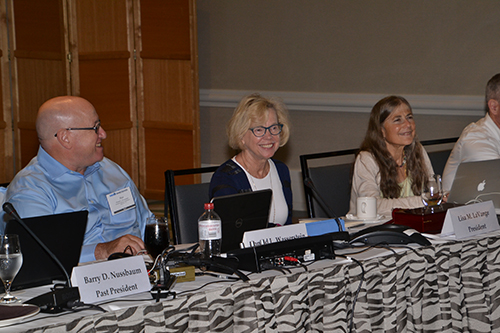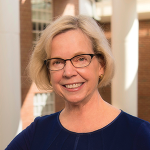With a Little Help from My Friends: Advice from the Board for Your Career Journey
This month’s issue of Amstat News focuses on careers and how the ASA can help. At JSM last week in Vancouver, I was reminded of the terrific resources provided to attendees and employers alike through the Career Service, located onsite.
Hundreds of employers and job candidates make connections each year through the Career Service. At FDA, where recruitment was a continuing need, we relied on the Career Service to identify interested and qualified candidates. If you missed JSM, you can take advantage of the ASA JobWeb.
Another resource for ASA members in their pursuit of career advancement is the Committee on Career Development. The committee’s mission is to “organize and promote activities, information, and materials to aid in the career development of statisticians and data scientists and to excite new interest in careers in these fields.” One resource the committee maintains is a list of professional development resources.

From left: Ron Wasserstein, Lisa LaVange, and Karen Kafadar during the ASA Board Meeting at the Joint Statistical Meetings 2018
Each year, just prior to JSM, the ASA Board meets to conduct a variety of business matters. I took the occasion of this issue’s focus on careers to solicit advice from members of the ASA Board: Barry Nussbaum (ASA past-president and retired chief statistician of the Environmental Protection Agency), Karen Kafadar (ASA president-elect and chair and commonwealth professor of statistics at the University of Virginia), G. David Williamson (ASA vice president and senior scientist at the US Centers for Disease Control and Prevention), Kathy Monti (ASA vice president and retired chief statistical scientist at Rho, Inc.), Katherine Halvorsen (ASA Council of Sections representative and professor of mathematics and statistics at Smith College), Jim Lepkowski (ASA Council of Sections representative and professor emeritus at the University of Michigan), Scott Evans (ASA publications representative and professor and director of the biostatistics center at The George Washington University), and Ron Wasserstein (ASA executive director). Here are some pearls of wisdom garnered from each of their distinguished and unique careers:
Q1. What is the best career advice you received?
Katherine: Persistence matters.
Scott: Think first, then research, then think again.
Kathy: Get a degree in statistics or biostatistics, rather than pure math. There are better job opportunities in stats-related fields. That was true then, and probably truer now.
Ron: Don’t wait for opportunities to come along. Volunteer to take on the extra job, or work on that committee, or help with that project.
Karen: Listen carefully to the problem. Often (s)he is not asking the right question.
Barry: My supervisor asked, “Just who do you think can read this memo?” It made me realize that we must always keep the customer in mind.
David: Have a strong work ethic to always do the best you can—then your career development and progress will take care of themselves.
Jim (from his dad, when worried about passing up a career opportunity that came at the wrong time): “There is always another street car,” referring to the Detroit of his childhood, where street cars stopped every couple of blocks and ran all the time. … Someone with as much talent and preparation and experience would always find another opportunity. … Have the confidence that opportunities would be there when you need them.
Q2. What tips can you offer for cover letters and résumés when applying for a job?
Barry: It is likely they will only read the cover letter, not the full CV. So step out fast and succinctly. In the CV itself, tell why you did some of your projects and give some substantive results.
Jim: A good proof reading, a few minutes’ extra effort, would have gone a long way to making sure that what I knew about them through the written materials gave a good impression.
Kathy: Explain why you are interested in the job and what you might bring to the job in the cover letter. Make the CV relevant to the job and well organized. Respect the page limits imposed by the application and in no case should one pad with long lists of minutiae. Perhaps the CV for the first job might include courses taken, but later in the career, this would be considered padding.
Karen: Make it personal, and, for heaven’s sake, correct spelling and grammatical errors. Padding the CV will leave a negative impression.
David: Construct your résumé so that it’s individualized to showcase your strengths to match with the needs and mission of the employer to whom you’re sending the resume.
Scott: Tailor the cover letter to the requirements expressed in the position announcement. For the CV, iterate several times to optimize organization, clarity, and efficiency. Keep it up to date.
Katherine: Keep the cover letter short and to the point. Have a friend or colleague review it before you send it.
Q3. What general career advice would you like to share?
Karen: Don’t hesitate to ask for help when needed.
Scott: Never stop being a student.
Kathy: Your education starts in school, but it doesn’t end there. Try to keep current in methods that are pertinent to your field once you move into the job market. Getting involved with the ASA’s chapters and sections can be an important part of your career. When thinking about your job options, don’t ignore the feel of the place.
Katherine: Don’t take a job because it pays well. To make the work worth doing, you need to like what you do and feel that what you are doing is meaningful.
Ron: Don’t be afraid to take risks, and don’t take rejection (as in not selected for the job) personally.
Barry: John Tukey once said, “The great thing about being a statistician is that you get to play in everyone else’s sandbox.” I have appended this with Nussbaum’s third postulate: “The person who owns the sandbox is impatiently waiting for a sturdy, useful sand castle to be constructed.”
David: The ball is in your court regarding your career. Work to gain personal traits and interpersonal skills that facilitate success (e.g., initiative, strong ethics, ability to communicate effectively orally and in writing), take training to acquire strong technical and nontechnical skills, find and be a good mentor, and identify your interests and passions and lay out your career path to integrate them. Strive to make a positive impact in as much of your job (and life) undertakings as possible. Make a difference!
When asked what courses they did not take but wished they had, responses ranged from the general—take more science courses—to the specific—chemistry, public speaking, logic, and theology. Jim said, “I wish I had a good course in systematic theology to help me begin to order thinking about what really matters.”
Thanks to these board members for their inspiring words of advice and encouragement. And thanks to the ASA for continuing to find ways to help members as they navigate their own career paths!
Sometimes, a second career warrants notice, and you can read about one such instance. Maura Stokes, senior scientist and director at SAS, published her first novel for young adults this summer, Fadeaway (Yellow Jacket, Bonnier Publishing USA, 2018). Whether a statistician writing on the side or vice versa, Maura has clearly managed to navigate a very successful career while still finding time for the things she is passionate about. A shout-out to Maura, whom I am proud to call a friend. And read the book—it is terrific! My grand-daughters have signed copies waiting for them (to learn to read!)


















